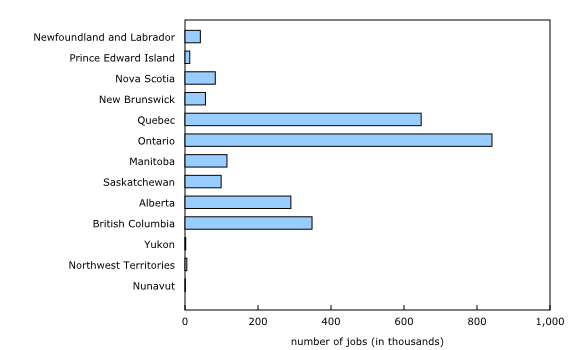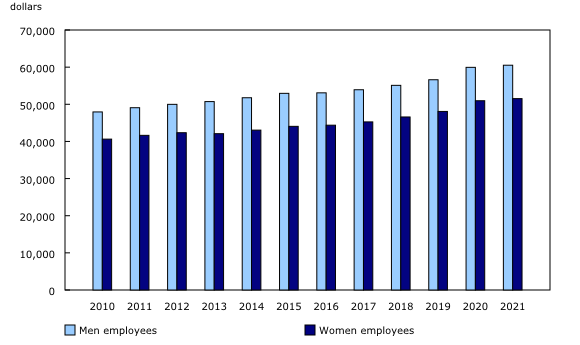Non-Profit Organizations and Volunteering Satellite Account: Human Resources Module, 2010 to 2021
Released: 2023-09-18
In 2021, non-profit organizations (NPOs) serving households, businesses and governments employed 2.5 million people, representing 14.5% of all jobs in Canada. NPOs serving governments employed 9.8% of the total Canadian workforce, the highest share among the non-profit sector. NPOs serving households employed 3.5% of total workers in Canada, followed by NPOs serving businesses, which employed 1.2%.
Ontario (33.1%) accounted for the largest share of NPO workers, followed by Quebec (24.5%) and British Columbia (13.7%).
In 2021, NPO employees earned on average $54,192 per year in wages and salaries, compared with economy-wide average earnings of $62,459. Excluding NPOs serving governments, NPO employees earned on average $45,944, 26.4% less than the economy-wide average.
Ontario ($57,876) recorded the highest average annual salaries and wages among the provinces, followed by Alberta ($54,981) and Newfoundland and Labrador ($54,131).
Women's employment share and gender pay gap stable over last decade
From 2010 to 2021, the share of total NPO jobs held by women remained stable, at around 70%. In addition, over the same period, a gender pay gap persisted, with women earning around 85 cents for every dollar men earned. In 2021, the largest gender pay discrepancy was recorded in NPOs serving businesses, with women earning 78 cents on average for every dollar men earned.
Highly educated workforce
In 2021, nearly three quarters (73.6%) of employees in NPOs had a college or university education, compared with the total economy, in which just over half (55.8%) of employees possessed a college or university education. However, among university and college graduates, those working in NPOs had average earnings of $60,964 in wages and salaries in 2021, while those economy-wide had average earnings of $73,459.
Share of immigrants outpacing total workers
In 2021, immigrants made up 26.6% of total NPO employees, up from 23.5% in 2010. The number of immigrant employees working in NPOs rose 31.0% from 2010 to 2021. At the same time, the number of immigrant employees in the overall economy grew by 24.8%. In 2021, immigrants and non-immigrants working in NPOs recorded similar annual average wages and salaries, at roughly $54,000.
Growth in Indigenous representation in non-profit sector
In 2021, Indigenous workers represented 4.5% of total NPO employees, up from 3.3% in 2010. The number of Indigenous workers in NPOs grew by 51.5% from 2010 to 2021, and the number of non-Indigenous workers increased by 15.1%. In 2021, Indigenous employees earned on average $45,452 in wages and salaries, while non-Indigenous employees earned on average $54,607. The wage gap persisted throughout the non-profit sector.
Aging workforce
As with the overall workforce, the age distribution of employees in the non-profit sector has been shifting, with a growing share of those aged 55 years and older. In 2021, 25.4% of NPO workers were aged 55 years and older, compared with 22.9% in 2010. Average earnings tended to be lower for those aged 55 years and older, compared with workers in their late thirties to early fifties, reflecting that a larger proportion of them worked part-time.
Note to readers
Human resources module (HRM) data for 2021 have been released along with the revised data from 2010 to 2020. The revisions are primarily due to the incorporation of preliminary results from the Human Resources Module of the Canadian Economy (HRMCE), which provides annual estimates for the years 2010 to 2021, including provincial and territorial estimates.
The aim of the HRM is to provide timely and reliable statistics on the human resource dimension of the production of non-profit organizations (NPOs) in Canada.
The Non-Profit Organizations and Volunteering Satellite Account already provides some information on the number of jobs generated by the sector at the national level. The HRM complements and enhances the analytical capacity provided by this product, allowing for a broader insight into the role of NPOs in the economy by providing more detailed human resource information.
The HRM provides annual estimates for the years 2010 to 2021, including provincial and territorial estimates. These estimates are based on data from the Canadian Productivity Accounts and the Labour Force Survey. Census data for 2011, 2016 and 2021 and data from the National Household Survey are also incorporated. The HRMCE will be available upon release in late 2023.
The wages and salaries presented in this release do not include supplementary labour income and self-employed jobs.
Data tables are accessible on request.
Business non-profit institutions include organizations such as chambers of commerce, business associations, protection services and condominium associations. These organizations do not fall under the direct control of the government, offer goods and services at low cost, and are constrained in their ability to redistribute any surplus they may generate. In standard macroeconomic measures, they are classified into the business sector.
Community non-profit institutions include organizations that provide services such as community food services, community housing, emergency relief, religious organizations, advocacy and sports and recreation. These organizations are not heavily influenced by the government and provide goods and services to households for free or at minimal cost. They are referred to as non-profit institutions serving households in standard macroeconomic measures.
Government non-profit institutions include hospitals, universities and colleges. These organizations are self-governing and exist independently of the government but are heavily influenced by it. They are classified as part of the government sector by conventional macroeconomic measures.
Products
The data visualization product "Annual Non-Profit Institutions Human Resource Module: Interactive tool," which is part of Statistics Canada – Data Visualization Products (71-607-X), is now available.
The Economic accounts statistics portal, accessible from the Subjects module of our website, features an up-to-date portrait of national and provincial economies and their structure.
The Latest Developments in the Canadian Economic Accounts (13-605-X) is available.
The User Guide: Canadian System of Macroeconomic Accounts (13-606-G) is available.
The Methodological Guide: Canadian System of Macroeconomic Accounts (13-607-X) is available.
Contact information
For more information, or to enquire about the concepts, methods or data quality of this release, contact us (toll-free 1-800-263-1136; 514-283-8300; infostats@statcan.gc.ca) or Media Relations (statcan.mediahotline-ligneinfomedias.statcan@statcan.gc.ca).
- Date modified:


